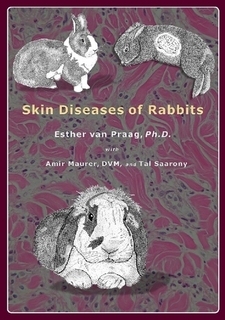Flått
Esther van
Praag, Ph.D. - Oversettelse av Camilla
Bergstrøm
|
MediRabbit.com is funded solely by the
generosity of donors. Every donation, no matter what the size, is appreciated and will aid
in the continuing research of medical care and health of rabbits. Thank
you |
Villkaniner blir regelmessig plaget av flått, både de med
ryggskjold (Ixodidae), og de uten (Argasidae). Haemaphysalis leporis
palustris observeres jevnlig hos amerikansk villkanin (Sylvilagus sp.)
og hare (Lepus sp.), men kan også forekomme hos den europeiske
villkaninen (Oryctolagus sp.). Intermediate stage ticks are
indeed light and easily carried by wind. They can enter a home through
windows left open, or ventilators placed in front of an open window. Ticks
can be categorized in two types:
• Ixotid ticks are
protected by a hard shield and their mouthpieces can clearly be seen. They
include commonly found ticks all over the world, like Ixodes
sp., Amblyomma sp., Boophilus
sp., Rhipicephalus sp., and Haemophysalis sp. All
can affect rabbits.
• Argasid ticks are soft ticks whose mouthparts and “false
head” (capitulum) cannot be seen when viewed from the
dorsal side. They live essentially in arid regions on the American continent,
Africa and India. Members of the Otobius sp., and Ornithodoros sp.
can plague rabbits.
Ticks are small (less than 5 mm in length) and have a
reddish or brownish color. Their life cycle is complex. Wild rabbits,
cottontails and hares are commonly plagued by Haemophysalys
leporis palustris.
This tick has typically three developmental phases, which occur on three
different hosts. After feeding blood or serum from its host, the tick larva
will fall to the ground, in order to molt. The next stage larva or nymph will
find a new host to feed on. Once adult, the tick will hide in the vegetation.
When it detects the presence of a host thanks to organs sensing its release
of CO2 release and body temperature, it will crawl onto its fur
and start engorging with blood. During the feeding, the tick will release
saliva and enzymes into its host, to keep the bite open. During this phase,
tick-borne diseases can be transmitted.
Flåttens
utviklingsmønster er grunnen til at huskaniner, som lever i rene og
hygieniske omgivelser, sjeldent angripes. Allikevel hender det at en og annen
flått setter seg på toppen av hodet, rundt eller på ørene, på øyelokk, bak i
nakken, eller under haken.
Symptomer
Ticks are usually found while inspecting the fur of a
rabbit. Preferred locations are the ears, the area between the ears, the neck
and the dewlap of female rabbits.
Severe infestation
can lead to macrocytic (enlarged red blood cells) normochromic (referring to
a red blood cell of normal color, usually because it contains the right amount
of hemoglobin) anemia.
Behandling
As much ticks as possible should be carefully removed with forceps and
killed rapidly by immersion in an acaricide solution, alcohol, or chloroform
solution. This avoids eventual contamination or spreading diseases carried by
the tick host. If the presence of further ticks is noticed, or if the infestation is
severe, administration of ivermectin (0.400 mg/kg, SC, once) is will
successfully get rid of the ticks. Although successfully killing ticks, the use of insecticide products
containing pyrethrin, permethrin, amitraz must be avoided, due to their
secondary toxic effects in rabbits. Fipronil is forbidden for use in rabbits. Severe tick infestation can lead to anemia and death. When observed in
a rabbit, blood transfusion from a healthy rabbit can be attempted. For detailed information on ticks
in rabbits, by E. van Praag, A.
Maurer and T. Saarony, 408 pages, 2010. Acknowledgements
Thanks are
due to David Fulmer for the permission to use the picture of an infested
cottontail. Videre informasjon
McGowan
MJ. Relationship between skin-sensitizing antibody production in the snowshoe
hare, Lepus americanus, and infestations by
the rabbit tick, Haemaphysalis leporispalustris (Acari: Ixodidae). J
Parasitol. 1985; 71(4):513-5. |
e-mail: info@medirabbit.com







